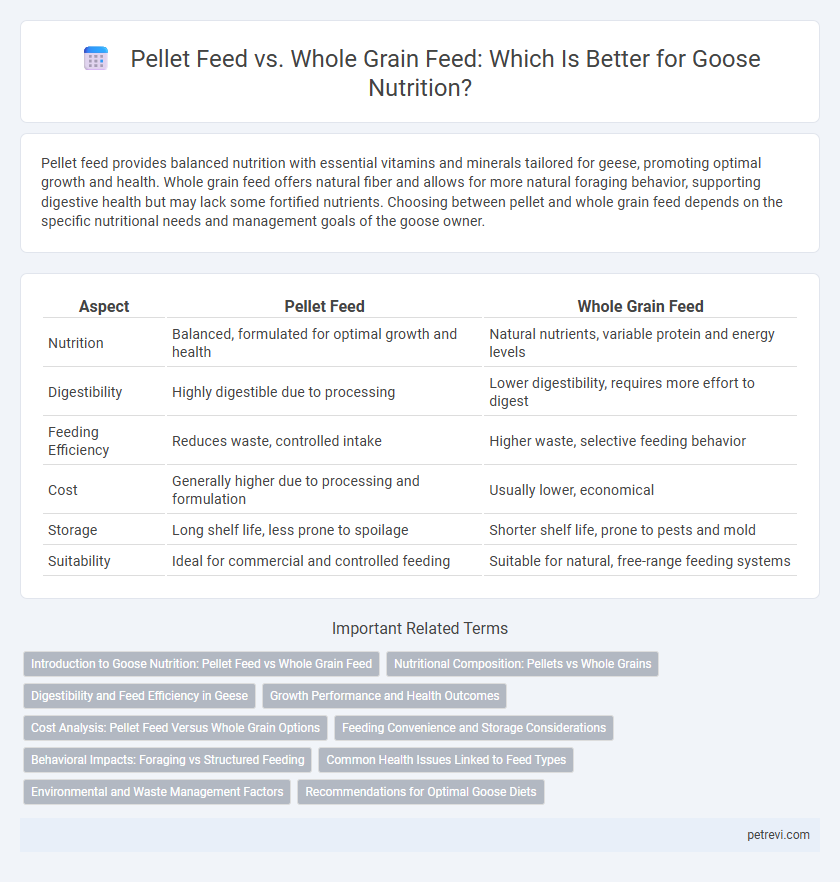Pellet feed provides balanced nutrition with essential vitamins and minerals tailored for geese, promoting optimal growth and health. Whole grain feed offers natural fiber and allows for more natural foraging behavior, supporting digestive health but may lack some fortified nutrients. Choosing between pellet and whole grain feed depends on the specific nutritional needs and management goals of the goose owner.
Table of Comparison
| Aspect | Pellet Feed | Whole Grain Feed |
|---|---|---|
| Nutrition | Balanced, formulated for optimal growth and health | Natural nutrients, variable protein and energy levels |
| Digestibility | Highly digestible due to processing | Lower digestibility, requires more effort to digest |
| Feeding Efficiency | Reduces waste, controlled intake | Higher waste, selective feeding behavior |
| Cost | Generally higher due to processing and formulation | Usually lower, economical |
| Storage | Long shelf life, less prone to spoilage | Shorter shelf life, prone to pests and mold |
| Suitability | Ideal for commercial and controlled feeding | Suitable for natural, free-range feeding systems |
Introduction to Goose Nutrition: Pellet Feed vs Whole Grain Feed
Pellet feed and whole grain feed offer distinct nutritional benefits for goose diets, with pellet feed providing a balanced mix of vitamins, minerals, and proteins tailored for optimized growth and health. Whole grain feed supports natural foraging behaviors and delivers essential carbohydrates and fiber that promote digestive health. Choosing the right feed depends on the geese's developmental stage, activity level, and specific nutritional requirements.
Nutritional Composition: Pellets vs Whole Grains
Pellet feed for geese offers a balanced nutritional composition with controlled levels of protein, fiber, vitamins, and minerals, enhancing digestibility and growth performance. Whole grain feed provides natural fiber and essential nutrients but may have variable nutrient content and lower digestibility compared to pellets. Optimizing goose nutrition involves selecting pellets to ensure consistent nutrient intake or whole grains to support natural foraging behavior and gut health.
Digestibility and Feed Efficiency in Geese
Pellet feed offers enhanced digestibility and feed efficiency in geese due to its uniform particle size and nutrient density, allowing for optimal nutrient absorption and reduced feed waste. Whole grain feed, while more natural, generally results in lower digestibility as coarse grains require more energy for digestion and may pass through the digestive tract less efficiently. Studies show pellet feed supports faster growth rates and improved feed conversion ratios in geese compared to whole grain diets.
Growth Performance and Health Outcomes
Pellet feed offers a balanced nutrient profile that supports consistent growth performance in geese by providing controlled protein, vitamins, and minerals essential for muscle development and immune function. Whole grain feed promotes natural foraging behavior and supports gut health through higher fiber content, but may result in slower growth rates due to variable nutrient intake. Optimizing goose nutrition involves balancing pellet feed to enhance growth and using whole grains to improve digestive health and reduce metabolic disorders.
Cost Analysis: Pellet Feed Versus Whole Grain Options
Pellet feed for geese often incurs higher upfront costs due to manufacturing and processing expenses compared to whole grain feed, which is generally more affordable and accessible as a natural feed source. However, pellet feed offers consistent nutrient levels that can enhance growth rates and improve feed conversion ratios, potentially reducing overall feeding costs over time. Whole grain feed, while cheaper per unit, may lead to variable nutrient intake and require larger quantities to meet nutritional needs, impacting cost-efficiency in commercial goose nutrition.
Feeding Convenience and Storage Considerations
Pellet feed for geese offers superior feeding convenience with uniform size and easy portion control, reducing waste and ensuring balanced nutrition. Whole grain feed requires more time to select and sort, often leading to uneven consumption and potential nutrient deficiencies. Pellet feed also benefits from compact storage with less risk of pest infestation, while whole grains demand more space and careful moisture management to prevent spoilage.
Behavioral Impacts: Foraging vs Structured Feeding
Pellet feed promotes structured feeding in geese, reducing foraging behaviors and potentially limiting natural instincts essential for mental stimulation. Whole grain feed encourages active foraging, supporting natural foraging behavior and enhancing cognitive engagement. Balancing pellet feed with whole grains can optimize nutrition while preserving important behavioral patterns in geese.
Common Health Issues Linked to Feed Types
Pellet feed for geese often leads to obesity and digestive problems due to its high energy density and processed nature, whereas whole grain feed supports better gut health and natural foraging behavior. Whole grains provide essential fiber that aids in preventing crop impaction and promotes steady digestion, reducing incidences of bloat and gastrointestinal discomfort. Nutritional balance in feed is vital to avoid diseases like fatty liver syndrome and to maintain optimal immune function in geese.
Environmental and Waste Management Factors
Pellet feed for geese generates less feed waste compared to whole grain feed, reducing environmental contamination from uneaten grains. The compact nature of pellets minimizes spillage, leading to more efficient feed utilization and lower nutrient runoff into surrounding soil and water systems. Whole grain feed can result in increased forage waste and higher risks of attracting pests, complicating waste management efforts on farms.
Recommendations for Optimal Goose Diets
Pellet feed offers balanced nutrition with precisely measured protein, vitamins, and minerals essential for optimal goose growth and health. Whole grain feed provides natural fiber and supports digestive health but may lack uniform nutrient density compared to pellets. Combining pellet feed with whole grains ensures a well-rounded diet, promoting better weight gain, feather quality, and overall vitality in geese.
Pellet feed vs Whole grain feed for Goose nutrition Infographic

 petrevi.com
petrevi.com